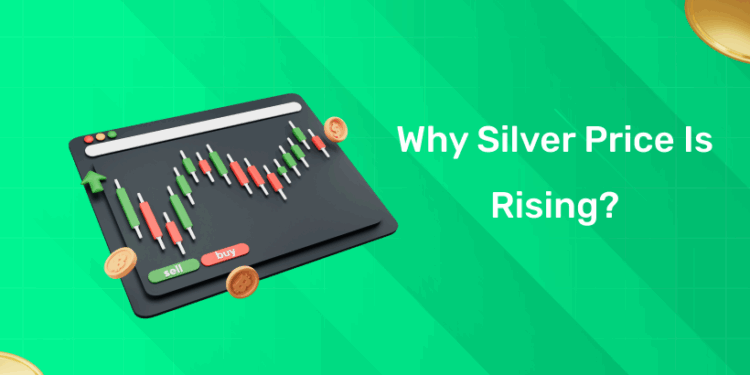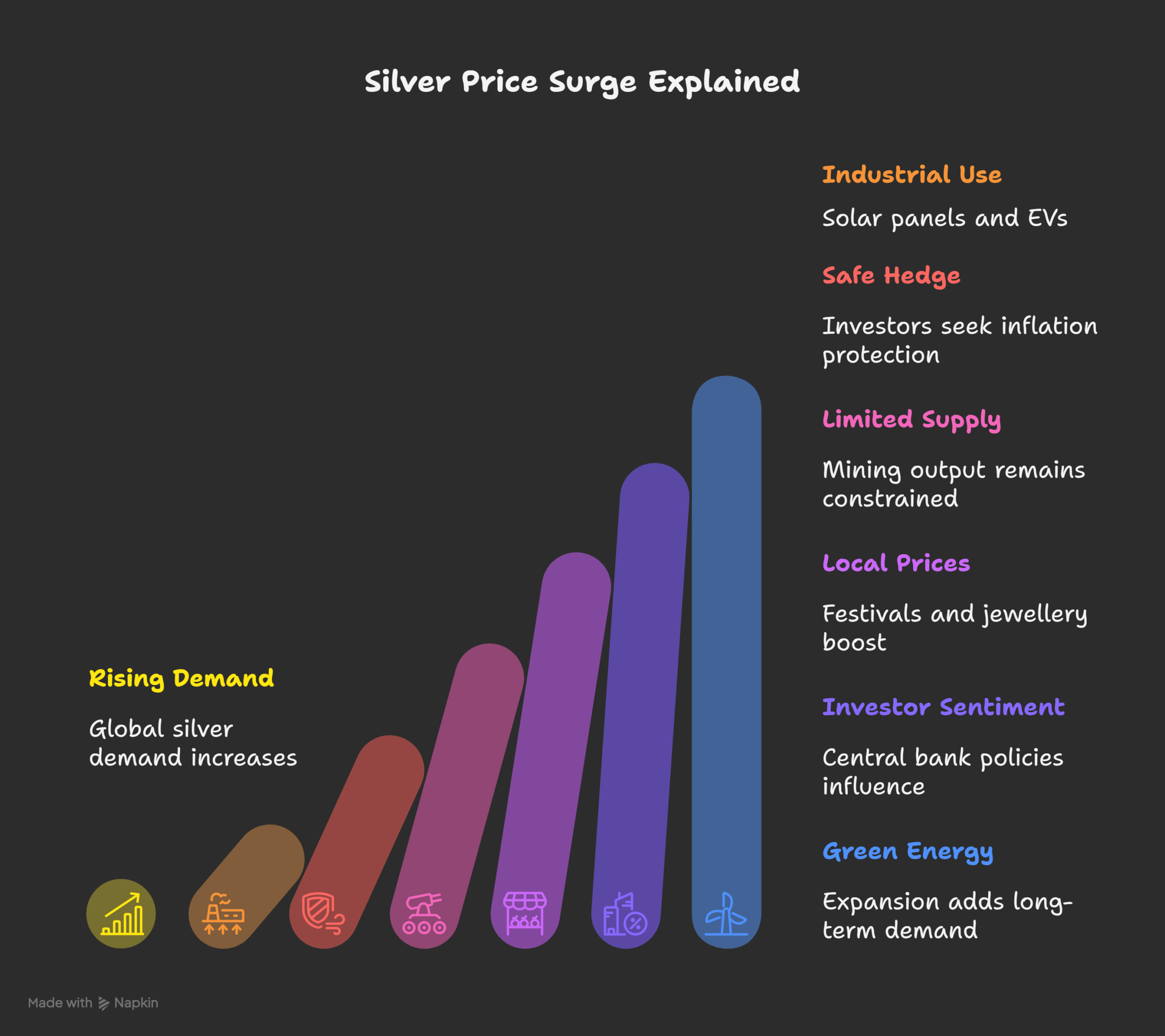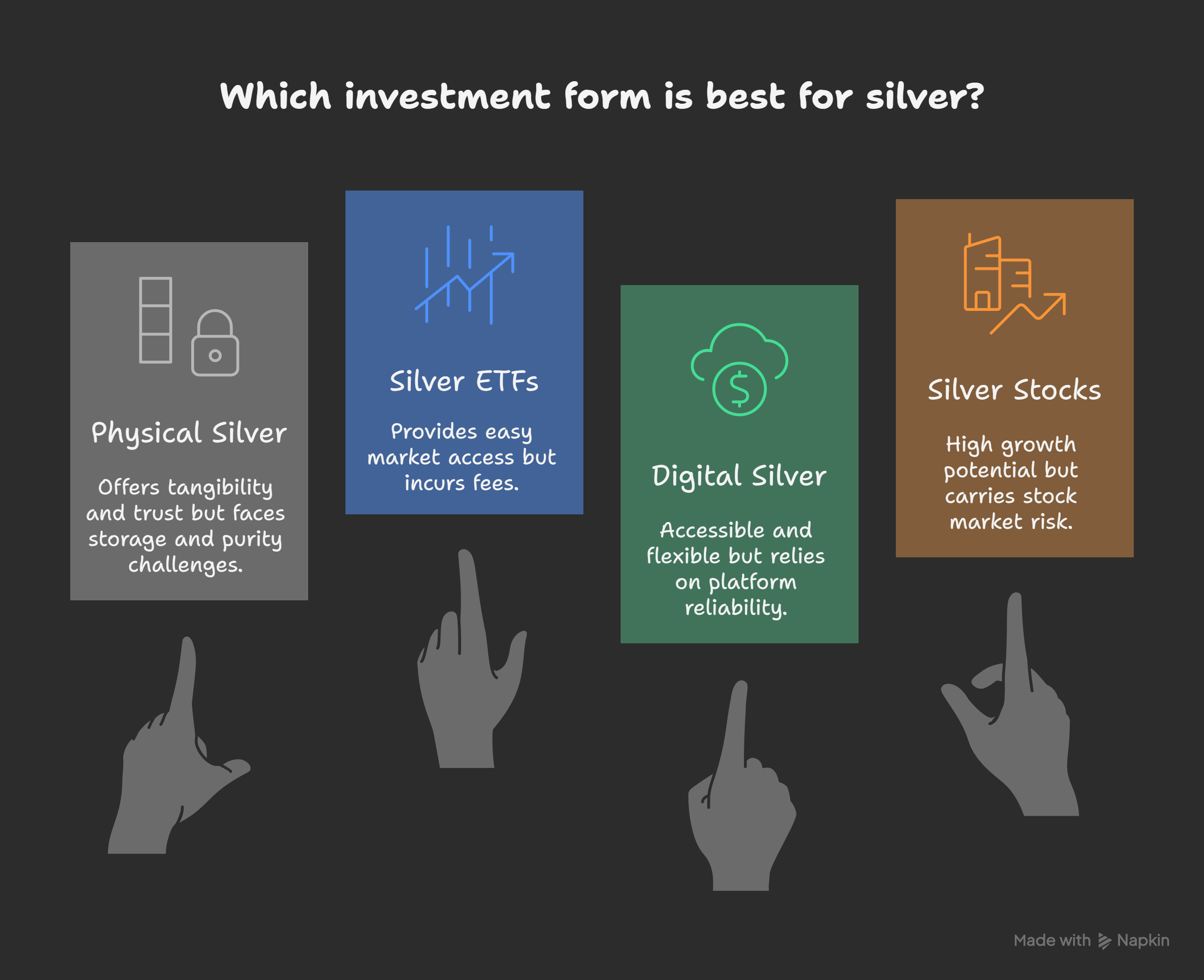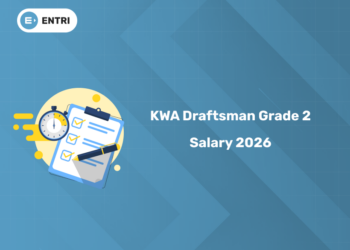Table of Contents
Silver has been shining brighter in recent months. Many are asking why silver price is rising. The metal’s value has surged across global markets. Investors and industries are both showing stronger demand. Silver is used in jewellery, electronics, and solar panels. Its mix of beauty and utility drives its importance. With global shifts, silver’s role is more vital now.
In India too, silver prices have touched record highs. Traders are witnessing low supply and rising buying interest. Festive demand and industrial needs add more pressure. Market experts see both opportunity and caution ahead. The changes reflect how global and local factors connect. Every small shift in demand impacts the price. Understanding these trends helps investors make wiser choices.
Key Highlights:
- Silver demand is rising worldwide.
- Industrial and green tech uses are growing.
- Supply shortages are pushing prices up.
- Festive demand boosts local Indian markets.
- Experts suggest watching global trends closely.
- Price movements may stay volatile in 2025.
- Knowing the reasons helps plan smarter investments.
Learn Stock Marketing with a Share Trading Expert! Explore Here!
Introduction
Silver prices have been climbing sharply in recent times. Many investors now wonder why silver price is rising. The trend reflects a mix of global and local factors. Industrial demand, investment interest, and market shortages play big roles. Silver is not just a precious metal for jewellery. It is also vital for electronics and renewable energy industries. These combined forces have made silver’s value soar steadily.
Across the world, markets are seeing strong buying pressure. Silver’s dual nature as an industrial and investment asset adds strength. When inflation rises, investors often turn to silver for safety. At the same time, factories need silver for green technologies. This creates a balance of practical and financial demand. The result is a steady upward push in prices. Many experts believe this trend will continue for a while.
Main Reasons for Silver’s Rise:
-
Global demand for silver is rapidly increasing.
-
Industrial use in solar panels and EVs is growing.
-
Investors view silver as a safe inflation hedge.
-
Limited mining output has tightened overall supply.
-
Rising festival and jewellery demand boosts local prices.
-
Central bank policies influence investor sentiment worldwide.
-
Green energy expansion adds strong long-term demand.
The Historical Context
1: What is a stock?
Silver has always held a unique place in history. It served as both currency and an industrial metal. Ancient civilizations used silver for trade and decoration. Over centuries, its role expanded beyond jewellery and coins. Today, it connects tradition with modern technology and global finance. The journey of silver shows how value changes with time. Understanding this background helps explain today’s rising prices.
Silver as a Precious Metal
Silver once symbolized wealth and social status. It was used in coins, utensils, and royal ornaments. People trusted silver for its beauty and lasting worth. Over time, it became a global standard of trade. When currencies changed, silver remained a trusted asset. Investors still see it as a store of value today. This old trust continues to influence modern price movements.
Key Points:
- Silver was used in ancient global trade.
- It acted as a measure of wealth.
- People still consider it a safe investment.
- Historical trust adds strength to silver’s image.
Silver’s Industrial Shift
In the 20th century, silver found new importance. It became essential in photography, electronics, and healthcare. With technology growth, its industrial role expanded further. Silver’s conductivity made it vital for modern devices. From solar panels to electric vehicles, demand keeps rising. This industrial use connects silver’s past to today’s innovation.
Industrial Applications of Silver:
| Sector | Common Uses | Impact on Demand |
|---|---|---|
| Electronics | Circuits, switches | Consistent growth |
| Solar Energy | Solar cells, panels | Rapid rise |
| Automotive | Electric vehicle parts | Strong demand |
| Healthcare | Antibacterial coatings | Moderate demand |
Highlights:
- Technology created new uses for silver.
- Industrial demand now drives global pricing.
- Energy transition increased silver consumption worldwide.
Global Price History
Silver’s price history shows cycles of highs and lows. In the 1970s, it spiked due to inflation fears. Later, it fell as markets stabilized. The 2010s saw another surge with economic uncertainty. Each rise followed strong investor or industrial demand. Today’s rally repeats this historic pattern in new conditions.
Price Patterns Over Time:
| Period | Main Driver | Market Effect |
|---|---|---|
| 1970s | Inflation fears | Sharp price rise |
| 1980s–1990s | Market stabilization | Price decline |
| 2010s | Global crisis fears | Renewed surge |
| 2020s | Green tech demand | Strong uptrend |
In Short
Silver’s story blends heritage and modern need. It moved from royal treasure to industrial essential. Both roles still shape how people value it today. History shows silver rises with demand and trust. That same pattern supports the recent price increases.
Stock Market Training Reviewed & Monitored by SEBI Registered RA
Trusted, concepts to help you grow with confidence. Enroll now and learn to start investing the right way.
Know moreWhat It Means for Investors
The rise in silver prices brings both opportunity and risk. Investors see silver as a strong hedge against inflation. Its growing use in industries adds more long-term value. However, high volatility can cause sudden price swings. Planning and timing are essential in silver investments today. Understanding personal goals and market conditions helps reduce risk. Investors should focus on patience and balanced strategies.
1. Short-Term vs Long-Term Investment
Investors must decide their preferred time horizon first. Short-term traders may face quick gains or losses. Long-term holders can benefit from steady industrial growth. Silver’s dual role makes both options possible but tricky.
Investment Comparison Table:
| Type | Duration | Benefit | Risk |
|---|---|---|---|
| Short-Term | Days to weeks | Quick profit chances | High volatility |
| Medium-Term | Months | Gain from trends | Market corrections |
| Long-Term | Years | Industrial growth support | Slower returns |
Key Tips:
-
Match investment duration with financial goals.
-
Avoid large positions in short-term trades.
-
Review prices regularly for exit timing.
2. Choosing the Right Investment Form
Silver can be bought in different ways today. Investors can choose physical bars, coins, or digital silver. ETFs and silver mutual funds offer easy online access. Each form carries unique benefits and costs.
Investment Options:
| Type | Description | Advantage | Limitation |
|---|---|---|---|
| Physical Silver | Bars, coins, ornaments | Tangible and trusted | Storage and purity issues |
| ETFs | Market-linked funds | Easy to buy or sell | Subject to market fees |
| Digital Silver | Online fractional silver | Accessible and flexible | Depends on platform reliability |
| Silver Stocks | Mining and tech shares | High growth potential | Stock market risk |
Tips:
-
Beginners can start with ETFs or digital silver.
-
Long-term savers prefer physical holdings.
-
Always verify authenticity and platform trust.
3. Managing Investment Risks
Silver’s fast price moves need disciplined risk control. Diversifying across gold, silver, and equities helps balance loss. Avoid emotional buying during market rallies. Use stop-loss and limit orders in online trades. Regular monitoring ensures safety from sudden downturns.
Risk Management Points:
-
Set clear entry and exit levels.
-
Diversify with other assets like gold.
-
Avoid investing all savings in one metal.
-
Follow verified news for real market updates.
4. Watching Global and Local Indicators
Silver prices react to global policies and local trends. Inflation rates, dollar strength, and rupee value affect prices. Festive seasons and industrial demand also move markets in India. Investors should stay updated on these key signals.
Market Indicators Table:
| Indicator | Influence | Observation |
|---|---|---|
| Global Inflation | High | Silver demand increases |
| USD Strength | Weak | Silver prices rise |
| Rupee Exchange | Weak | Import cost increases |
| Festive Demand | Strong | Local price support |
In Short
Investing in silver needs balance and awareness. It offers protection, growth, and diversification together. Yet, volatility demands discipline and regular observation. Choosing the right method and time frame is vital. Informed investors can benefit while managing possible risks.
Key Takeaways:
-
Silver prices are rising due to global demand.
-
Industrial use strongly supports long-term price growth.
-
Investor interest adds extra pressure on supply.
-
Limited mining output keeps market conditions tight.
-
Inflation and weak dollar boost silver’s appeal.
-
Indian festive demand increases local price movement.
-
Experts advise caution amid short-term volatility.
-
Diversified portfolios reduce silver investment risks.
-
Staying updated helps make smarter investment choices.
-
Silver remains a strong hedge and growth asset.
Conclusion
Silver continues to shine as prices climb steadily. Both investors and industries watch its every move. Limited supply and rising demand push values higher. Industrial growth and green technology add long-term support. Global economic trends and currency shifts affect prices. Indian markets mirror global trends with seasonal spikes. Understanding these forces helps investors act wisely.
Caution is key while seeking silver’s potential gains. Volatility can create quick profits or sudden losses. Choosing the right investment type matters greatly today. Diversifying holdings reduces risk and protects capital over time. Short-term trends may excite, but long-term demand matters most. Staying informed helps navigate both global and local changes. Silver remains a valuable metal for strategy and growth.
Stock Market Training Reviewed & Monitored by SEBI Registered RA
Trusted, concepts to help you grow with confidence. Enroll now and learn to start investing the right way.
Know moreFrequently Asked Questions
Why is silver price rising sharply in 2025?
Silver prices are rising due to a combination of factors. Strong industrial demand from solar panels, electric vehicles, and electronics has increased physical consumption. At the same time, investors are turning to silver as a safe-haven asset during inflation and currency fluctuations. Limited mining output and delays in production recovery add supply constraints, which further push prices upward. Global economic uncertainty and speculative trading also amplify short-term price movements, making silver one of the most sought-after metals in 2025.
How does industrial demand impact silver prices?
Industrial demand directly affects silver prices because a large portion of silver is used in technology and manufacturing. Solar energy, electronics, and electric vehicle components require silver for conductivity and efficiency. As green energy and tech adoption expand worldwide, industrial consumption rises, reducing the available supply in the market. This steady demand ensures that silver’s value receives long-term support, unlike purely speculative assets, making price surges more sustainable during periods of high industrial activity.
What role do investors play in the silver price surge?
Investors significantly influence silver prices by buying silver bars, coins, and ETFs. When inflation fears rise or currency values weaken, investors view silver as a hedge, increasing demand rapidly. Large institutional inflows into silver-backed funds amplify the price movement. Retail investors following global trends also contribute to momentum trading. Collectively, this investor behavior creates strong upward pressure on prices, often leading to short-term spikes and heightened volatility in both global and local markets.
How does supply shortage affect silver prices?
Supply shortage is a major driver of price increases. Mining production has struggled to meet demand due to slower post-pandemic recovery and regulatory constraints. Recycling of silver cannot fully compensate for reduced mining output. Physical stocks in vaults and warehouses remain low, pushing spot premiums higher. When supply is tight and demand continues to grow, even minor fluctuations can trigger sharp price surges, making the market more sensitive to investor and industrial actions.
How do global economic factors influence silver prices?
Global economic factors like inflation, currency strength, and central bank policies affect silver heavily. A weaker U.S. dollar usually makes silver cheaper for foreign buyers, driving up demand. Inflation fears push investors toward tangible assets like silver as a store of value. Interest rate changes and monetary policy decisions can also influence investor behavior and market momentum. Even small shifts in global markets can create large swings in silver prices because it is both an industrial commodity and a precious metal.
How does the rising silver price affect Indian markets?
In India, silver is widely used in jewellery, investment bars, and industrial applications. Rising global prices lead to higher local import costs, which in turn push retail and wholesale prices upward. Festive seasons and wedding demand intensify the effect, as buyers rush to purchase silver ornaments and coins. Traders and jewellers often adjust prices daily to reflect international trends and local demand. Industrial users also face increased input costs for electronics and solar panel production, influencing manufacturing expenses and product pricing.
Is silver a safe investment during high volatility?
Silver can serve as a safe investment if approached strategically, but it is more volatile than gold. Its price can rise quickly due to investor sentiment, industrial demand, or supply constraints, but it can also fall sharply during corrections. Risk management is crucial: investors should diversify holdings, set stop-loss limits, and avoid overexposure. Long-term investors benefit from industrial and technological demand trends, while short-term traders must monitor market signals carefully. Proper planning and awareness reduce the impact of sudden price swings.
What are the best ways to invest in silver?
Investors can access silver through multiple options: physical bars and coins, silver-backed ETFs, digital silver platforms, or shares of silver mining companies. Physical silver offers tangible ownership but requires secure storage and attention to purity. ETFs provide liquidity and easy market access without storage issues. Digital silver allows fractional ownership and online management, though it depends on platform reliability. Mining stocks offer leveraged exposure but carry additional stock market risk. Each option suits different investment strategies and risk appetites.
Will silver prices continue to rise in the near future?
Experts are cautiously optimistic about silver’s near-term prospects. Industrial demand, supply constraints, and inflation hedging continue to support higher prices. However, sudden corrections are possible due to profit-taking, changes in global monetary policy, or improved supply. Analysts suggest that while the long-term trend may remain upward, short-term volatility is likely. Investors should combine careful research, monitoring of market indicators, and disciplined strategies to benefit from future price movements without taking excessive risk.
How can investors minimize risks while investing in silver?
Risk management is essential for silver investors due to its price volatility. Diversifying investments across metals, equities, and other assets reduces exposure. Using stop-loss orders, setting entry and exit levels, and avoiding emotional decisions help prevent large losses. Staying updated on global trends, currency movements, industrial demand, and local market conditions is crucial. Investing in both physical and financial silver instruments, according to risk tolerance and time horizon, allows balanced participation while limiting potential downsides in the market.














